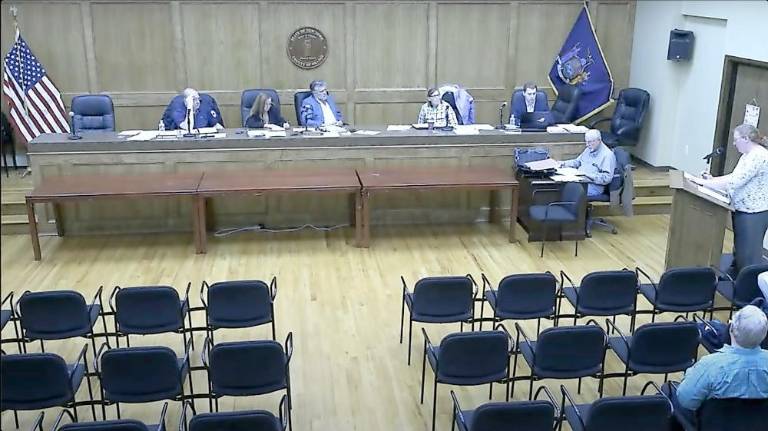Chester Town Board considers dividing the town into wards
Chester. Wards, created for political representation, should be of equal size, based on the most recent census, said Megan Tennermann, senior planner of the Orange County Planning Department, who attended the meeting to provided information about wards to the town board. Public comments addressed the value of conservation advisory committees, the prospect of a 150’ cell tower, training on municipal processes and decommissioning.

Megan Tennermann, senior planner at Orange County Planning Department, appeared at the Nov. 9 Chester Town Board meeting to provide information about wards, or electoral districts.
“Brandon graciously asked Megan to come out...we’re trying to wrap ourselves around wards because it’s something that it’s time that we do,” said Town Supervisor Robert Valentine, referring to Town Councilman Brandon Holdridge.
Tennermann explained that ward districts must be drawn equally “to get as close as possible to one person, one vote,” ensuring voting representation for all residents. The Town of Chester, for example, has a population of 12,646 residents, so the area would be split into four wards, and each district would contain about 3,161 residents. If the districts aren’t perfectly even, a rule is in place for that.
“New York State has set that standard at plus or minus five percent so that the largest district is no more than 10 percent larger than the smallest district in any given area that is enumerated,” Tennermann said.
Valentine raised concerns about an upcoming large development that will likely add over a thousand votes to the area. “How does that skew all the other districts in that formula?” he asked.
“What you’re allowed to do when forming the wards is to use the most recent census data because those houses are not built yet...your enumerated population is your legal population for the decade of 2020s, so technically you do not have to take that into account,” Tennermann said.
Councilman Robert Courtenay asked about determining a ward’s average size. “Is there a standard for what size or how many people per ward? Or is that based on the total number of people living in the community?” he asked.
“Not necessarily. Once your ward boundaries are set, you do not have to re-delineate them...it’s not like a legislative seat where you do have to re-delineate the ward boundaries every 10 years following the release of the new census data. I would have you ask your attorney if you were also required to do that,” Tennermann said.
Tennerman also suggested that the board redraw their election districts prior to establishing the wards. “That is a significant time investment, probably a month to six weeks...the Board of Elections and the GIS Division at the county would be responsible for redrawing that,” she said.
The board agreed with her and resolved to redraw. “Let’s make a resolution to direct the county to redraw the election districts,” said Valentine.
Opening public comment, town resident Larry Dysinger questioned the town’s regulations regarding decommission.
“The only place where it is referenced at this point is for solar arrays. However, it really applies to any commercial structure...solar arrays, telecommunication towers, or the like,” he said.
Dysinger also wanted clarification on which board is responsible for handling decommissioning, the town board or the planning board, and he suggested that decommissioning be expanded in its own chapter in town rules “because it applies to more than just solar arrays.” Town Supervisor Robert Valentine thanked him for his input.
Then another resident, Tracy Schuh, informed the board that the New York State Association of Conservation Commission and Orange County Planning Department will be hosting a Zoom meeting on November 30 that promotes the benefits of conservation advisory committees.
“There are several municipalities that already have them doing good work in their communities...for preservation plans, they address environmental research for town boards. I thought such a group would be great for Chester,” she said, adding that a CAC could also help the board obtain and review grants.
Schuh also brought up public concerns about a cell phone tower slated for construction near the Walton Lake Estates.
“One comment that kept coming up from the public was that they wanted to know alternate locations...I know you guys said that people’s concerns would be addressed there,” she said. “It’s going to be 150 feet, and it’s not going to be camouflaged.”
Schuh also announced a workshop to be hosted by the town’s planning board chairman on November 16 for in-house training and suggested more trainings.
“I think it’s important that the public learns about these processes, as well as the town board because you also do SEQR (State Environmental Quality Review) determinations, but you don’t have the same training that the planning board has,” she said.
Valentine thanked Schuh for her input.